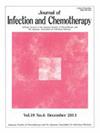Clinical characteristics of community-acquired primary pleural infection compared to postpneumonic pleural infection: a retrospective study
IF 1.5
4区 医学
Q3 INFECTIOUS DISEASES
引用次数: 0
Abstract
Background
Data on the clinical features and treatment outcomes in patients with primary pleural infection (PI) are limited. This study aimed to investigate the clinical characteristics of these patients.
Patients and methods
In this retrospective study, patients with community-acquired PI, diagnosed based on pleural fluid analysis, were classified into postpneumonic and primary PI groups according to computed tomography (CT) findings. Clinical variables, microbiological data, and CT findings were compared between the two groups.
Results
Approximately 28 % of patients with community-acquired PI presented as primary PI. Treatment success rates and in-hospital or 30-day mortality were comparable between the two groups. However, compared to the postpneumonic PI group, the primary PI group was significantly younger and had lower proportions of patients with Pneumonia Severity Index classes 4–5 and RAPID (Renal, Age, Purulence, Infection source, and Dietary factors) score >3. On CT scans, subpleural abscesses were present in less than half of the patients in the primary PI group, compared to most patients in the postpneumonic PI group. Pleural enhancement and extrapleural fat proliferation were more frequently observed in patients with primary PI than in those with postpneumonic PI. In the primary PI group, Streptococcus anginosus group was the most common pathogen, accounting for nearly half of the causative organisms.
Conclusions
Patients with primary PI had similar treatment outcomes compared to those with postpneumonic PI. However, different causative pathogens and radiologic findings of primary PI suggest a distinct pathogenesis of PI independent of pneumonia.
社区获得性原发性胸膜感染与肺炎后胸膜感染的临床特征比较:一项回顾性研究
背景:关于原发性胸膜感染(PI)患者的临床特征和治疗结果的资料有限。本研究旨在探讨这些患者的临床特点。患者和方法在这项回顾性研究中,根据计算机断层扫描(CT)结果,将基于胸膜液分析诊断的社区获得性PI患者分为肺炎后组和原发性PI组。比较两组患者的临床变量、微生物学数据和CT表现。结果约28%的社区获得性PI患者表现为原发性PI。两组之间的治疗成功率和住院或30天死亡率具有可比性。然而,与肺炎后PI组相比,原发性PI组明显更年轻,肺炎严重程度指数4-5级和RAPID(肾脏、年龄、脓毒、感染源和饮食因素)评分[gt;3]的患者比例更低。CT扫描显示,与肺炎后PI组的大多数患者相比,原发性PI组中不到一半的患者存在胸膜下脓肿。原发性PI患者胸膜增强和胸膜外脂肪增生比肺炎后PI患者更常见。在原发性PI组中,最常见的病原体是血管链球菌组,占病原菌的近一半。结论原发性PI患者与肺炎后PI患者的治疗结果相似。然而,原发性PI的不同致病病原体和影像学表现表明PI的发病机制与肺炎无关。
本文章由计算机程序翻译,如有差异,请以英文原文为准。
求助全文
约1分钟内获得全文
求助全文
来源期刊

Journal of Infection and Chemotherapy
INFECTIOUS DISEASES-PHARMACOLOGY & PHARMACY
CiteScore
4.10
自引率
4.50%
发文量
303
审稿时长
47 days
期刊介绍:
The Journal of Infection and Chemotherapy (JIC) — official journal of the Japanese Society of Chemotherapy and The Japanese Association for Infectious Diseases — welcomes original papers, laboratory or clinical, as well as case reports, notes, committee reports, surveillance and guidelines from all parts of the world on all aspects of chemotherapy, covering the pathogenesis, diagnosis, treatment, and control of infection, including treatment with anticancer drugs. Experimental studies on animal models and pharmacokinetics, and reports on epidemiology and clinical trials are particularly welcome.
 求助内容:
求助内容: 应助结果提醒方式:
应助结果提醒方式:


